![]()
Aroids and other genera in the Collection
Take the Tour Now?
Orchids
The
Exotic Rainforest
Plants in
the Exotic Rainforest Collection
Images on this website are copyright protected. Contact
us before attempting to reuse.
In depth information on how to grow Philodendron species, Click this Link
Within our collection we have many species of Philodendron.
If you are seeking other photos,
click this link
Philodendron pseudauriculatum
Croat
Philodendron pseudauriculatum
Croat
Although it may appear to some the word "pseudo" should have been used,
in Latin "pseud" is used as a combining form as when combining the words
"pseudo" (meaning not authentic) and "auriculatum" (to possess ear lobes).
The species is found at elevations ranging from
20 to 1400 meters (65 to 4600 feet) above sea level and occurs in pre-mountainous wet
forests as well as as wet rain forest zones. The majority of
collections of Philodendron pseudauriculatum have been made near La Mesa (Coclé), Cerro Campana
in south central Panama where it may be observed along the road leading from El Llano
to Cartí. It is also known from a lone collection in Bocas del Toro
on the mid-central Atlantic coast as well as a collection in the Serranía de Cañasas
near the Pacific Ocean.
The genus Philodendron
is divided into three subgenera including subgenus Philodendron,
subgenus Meconostigma and
subgenus Pteromischum.
These subgenera are further divided into sections as well as subsections
and series based on the specific characteristics of a species.
Philodendron pseudauriculatum is a member of Philodendron
subgenus Philodendron, section
Calostigma, subsection Glossophyllum and is placed in series
Glossophyllum. The type specimen was collected in
A
climbing vine,
Philodendron pseudauriculatum grows as a hemiepiphytic species
and climbs appressed to its host tree. A
hemiepiphyte (hem-a-EPA-fit) is a plant that may begin life as a seed which falls to the
ground or as a seed which was placed on the branch of a tree in the
droppings of a bird or other rain forest animal that subsequently
sends its
roots to the soil. An appressed vine is one that grows pressed
quite close to its host.
Blades
The leaf blades of
Philodendron pseudauriculatum stand erect and grow in a roughly
rosulate form (photo above, right). Rosulate indicates the leaves spread in a
relatively
uniform
pattern around the central axis as well as grow in a formation similar to the petals of a
rose. The leaf blades of
Philodendron pseudauriculatum grow with
oblong-elliptic to
oblanceolate-elliptic shape which describes a blade
that is both oblong while elliptical (wider at the center) and/or shaped
similarly to the weapon known as a lance (lanceolate). The blades are
considered subcoriaceous to coriaceous.
The basal leaf veins at the extreme top of a
leaf's lobe grow from the midrib uninterrupted (free) to the base
There are 8 to 14 primary lateral veins
on each side of the midrib (see photos above and right) which depart the midrib at an
angle of 65 to 75 degrees but the angle narrows
nearer the apex (top) of the blade. The primary veins run almost straight to the margins
(edges) of the leaves and are sunken on the upper surface while raised
on the underside of the blade. The
primaries are somewhat paler
in color on the abaxial surface of a blade. The interprimary veins
are flat as well as
darker on the underside and arise from both the midrib and primary
lateral veins. The tertiary or minor veins are only
slightly distinct on the underside.
Petioles
Philodendron species are members of the larger
plant family known as Araceae and are commonly called aroids. Aroids
are characterized by the growth an inflorescence known to science
as a spathe and spadix which contain the reproductive organs
of the plant. The spathe is simply a
modified leaf which
appears in the
shape of a hood while the spadix is located at the
center of the inflorescence.
The spadix is a spike on a thickened fleshy axis which can produce tiny
flowers. Despite being called a
"flower" on far too many websites the spathe is
not a flower. Flowers contain
near microscopic sexual parts including
the anthers, stamens, and stigmas when the plant is in the reproductive
process. A spathe contains none of these sexual characteristics
but all can be observed with a good
When ready to reproduce the spadix of a Philodendron produces male,
female and sterile flowers which are cleverly divided by
nature into separate zones in order to prevent self
pollination. The female flowers as well as the sterile
male flowers are hidden inside a
region at the bottom of the spathe known as the "floral
chamber" while the fertile male flowers are exposed on the visible
portion of the spadix. The purpose of the sterile male
flowers is to produce a perfume-like substance known as a pheromone
which attracts pollinating insects. The sterile flowers also serve
as a source of food in the form of protein to those pollinators. Philodendron species
produce the female flowers on the first evening of anthesis and are no
longer receptive by the time the male flowers begin to produce pollen on
the second (possibly the third) evening. If the female flowers are pollinated with pollen
of the same species which is already at male anthesis carried by an appropriate
beetle in the genus Cyclocephala from another
specimen
they will produce berries containing seeds.
The berries (fruits) are white turning to orange when mature and the berries
normally contain 5 seeds per berry.
For more information how Philodendron and other
aroids reproduce click this link
Aroid Pollination The specimen shown in the photos
on this page was acquired for the ExoticRainforest collection as an adult specimen grown from a cutting from the collection of the
Missouri Botanical Garden. The specimen was grown at MOBOT from
specimen number 33526. The parent plant was collected by Dr. Croat
on March 21, 1976 near Nuevo Tonosi 32. KM (2
miles) from Portobello on the road to Nombre de Dios, Panama at an
elevation of 100 meters (330 feet) above sea level, The exact collection
coordinates were recorded as 09°33'00"N 079°37'30"W
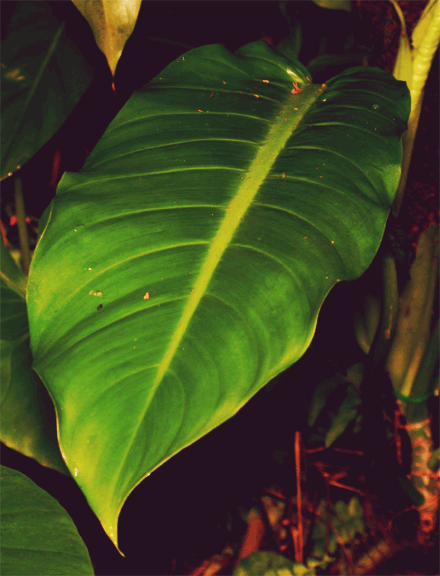
Note: Despite the fact it may appear this name should
begin with "pseudo" the scientific spelling on this page is correct.
P. pseudoauriculatum is an incorrect spelling
Philodendron pseudauriculatum
(suud-AH-ric-u-lat-um) was published to science in the
Annals of the Missouri Botanical Garden Volume 84, Number 3 in 1997.
The species was described by
aroid botanist Dr. Thomas B. Croat Ph.D., P.A. Schulze Curator of Botany
of the Missouri Botanical Garden in St. Louis. Dr. Croat is one of
the world's leading aroid scientists. The description can be found
on page 498 of that journal and all the scientific material in this article was taken
from that publication. 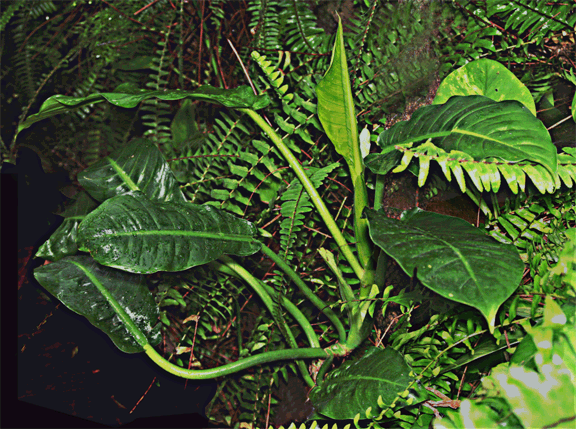 Philodendron pseudauriculatum occurs only in Panama
as well as in the in the northwestern portion of the adjacent country of Colombia
down to Antioquia. Although the specimens found in the
Chocó
differ somewhat it is
also possible this species may occur in
Chocó Department
(similar to a state) in western Colombia.
Philodendron pseudauriculatum occurs only in Panama
as well as in the in the northwestern portion of the adjacent country of Colombia
down to Antioquia. Although the specimens found in the
Chocó
differ somewhat it is
also possible this species may occur in
Chocó Department
(similar to a state) in western Colombia.
Philodendron pseudauriculatum
is somewhat similar in shape (thus
its name) to Philodendron auriculatum
which is
primarily from Costa Rica but has also been observed in Panama,
Colombia and Brazil.
Philodendron
auriculatum can
be distinguished
since it possesses
leaf blades
that dry to a pale
yellow green color and has more narrow posterior lobes
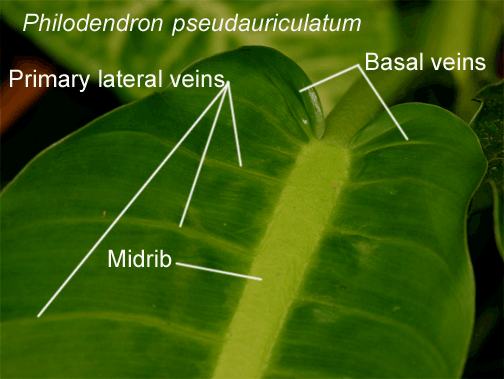 toward the base.
The term auriculate
indicates the plant has "ears" or earlobe-shaped extensions at the
base which is the
top of the blade (see photos below).
Philodendron pseudauriculatum is
even more easily confused with
Philodendron ligulatum
as well as
several natural variations of that species since they have
similarly shaped blades.
Based on Dr. Croat's work Philodendron pseudauriculatum also
bears a similarity to Philodendron dolichophyllum which is
another Panamanian species placed in Philodendron section
Glossophyllum.
Both species possess petioles and blades of similar length but
Philodendron pseudauriculatum differs by having much shorter leaves
as well as sunken primary lateral leaf veins (see explanation below).
There is also a similarity to Philodendron bakeri but P.
bakeri has much fewer primary lateral leaf veins (3 to 4) and the
annulus (colored ring) at the top of the petiole is purple instead of
green.
toward the base.
The term auriculate
indicates the plant has "ears" or earlobe-shaped extensions at the
base which is the
top of the blade (see photos below).
Philodendron pseudauriculatum is
even more easily confused with
Philodendron ligulatum
as well as
several natural variations of that species since they have
similarly shaped blades.
Based on Dr. Croat's work Philodendron pseudauriculatum also
bears a similarity to Philodendron dolichophyllum which is
another Panamanian species placed in Philodendron section
Glossophyllum.
Both species possess petioles and blades of similar length but
Philodendron pseudauriculatum differs by having much shorter leaves
as well as sunken primary lateral leaf veins (see explanation below).
There is also a similarity to Philodendron bakeri but P.
bakeri has much fewer primary lateral leaf veins (3 to 4) and the
annulus (colored ring) at the top of the petiole is purple instead of
green.
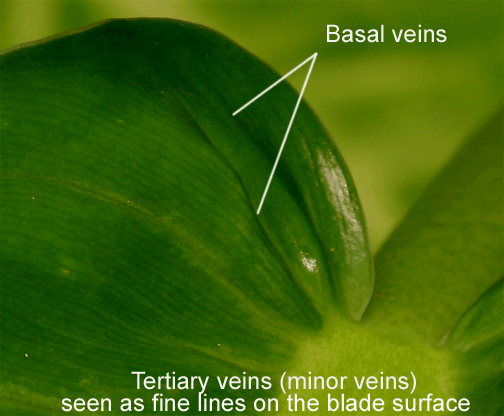 When attempting to identify any
aroid species the specific characteristics of the specimen being researched are
important. One goal of this article is to attempt to explain and illustrate those
distinguishing characteristics in a way any collector can use to verify whether or not a plant
is or is not the species in question. Although scientific terminology is
used in this article we attempt to explain each term so the reader may find this
article both explanative and educational. Please do not abandon
reading this piece simply because scientific language is used.
When attempting to identify any
aroid species the specific characteristics of the specimen being researched are
important. One goal of this article is to attempt to explain and illustrate those
distinguishing characteristics in a way any collector can use to verify whether or not a plant
is or is not the species in question. Although scientific terminology is
used in this article we attempt to explain each term so the reader may find this
article both explanative and educational. Please do not abandon
reading this piece simply because scientific language is used.
Since all Philodendron species (and many other plants) are
variable some characteristics including the shape of the blade,
coloration of the inflorescence and other features may vary from
specimen to specimen. You should not assume every single specimen
of any species will look exactly alike.
For an explanation of natural variability in aroids please consult this
link:
Natural variation in aroids Subcoriaceous indicates the blades are less than leathery to the touch
while coriaceous indicates they possess the feel of leather. The
leaf blades are slightly to markedly two colored (bicolorous) and are
semi-glossy on the adaxial (upper) blade surface. The blades are also acuminate.
The botanical term acuminate indicates the blades taper to a
point. Since this species is variable the blades may also be sub-cordate (heart
shaped) which would indicate they may grow with an exaggerated as well
as elongated heart shape. The
blades may be between 27 to 80 cm (10.5 to almost 32
inches) in length. Although not always present, when it is
observed the sinus may be as deep as 2.5 cm
(almost 1 inch) in depth. A sinus is the opening between the
lobes near the base (top) of the leaf blade.
Subcoriaceous indicates the blades are less than leathery to the touch
while coriaceous indicates they possess the feel of leather. The
leaf blades are slightly to markedly two colored (bicolorous) and are
semi-glossy on the adaxial (upper) blade surface. The blades are also acuminate.
The botanical term acuminate indicates the blades taper to a
point. Since this species is variable the blades may also be sub-cordate (heart
shaped) which would indicate they may grow with an exaggerated as well
as elongated heart shape. The
blades may be between 27 to 80 cm (10.5 to almost 32
inches) in length. Although not always present, when it is
observed the sinus may be as deep as 2.5 cm
(almost 1 inch) in depth. A sinus is the opening between the
lobes near the base (top) of the leaf blade.
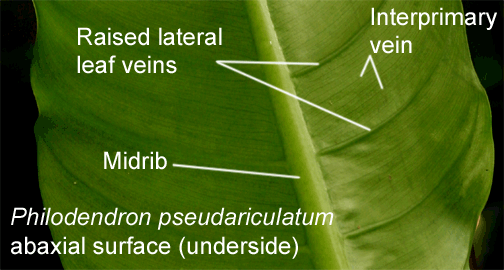 The veins on any leaf are divided into classifications
which include the basal
ribs, midrib, primary lateral veins, interprimary veins and tertiary or
minor veins The midrib at the center of any leaf of
Philodendron pseudauriculatum is flattened at the
base but slightly
sulcate midway
down
the rib. The term sulcate may indicate either a canal running
along the rib or small parallel groves running along its axis. The midrib is also
widely convex (raised) at the apex (top) as well as concolorous (single
colored) on the
upper blade surface. The midrib is paler
in color on the underside (abaxial surface) of the leaf
blade. The lower surface of the midrib (abaxial) exhibits short green lines
and is lineate (lined).
The veins on any leaf are divided into classifications
which include the basal
ribs, midrib, primary lateral veins, interprimary veins and tertiary or
minor veins The midrib at the center of any leaf of
Philodendron pseudauriculatum is flattened at the
base but slightly
sulcate midway
down
the rib. The term sulcate may indicate either a canal running
along the rib or small parallel groves running along its axis. The midrib is also
widely convex (raised) at the apex (top) as well as concolorous (single
colored) on the
upper blade surface. The midrib is paler
in color on the underside (abaxial surface) of the leaf
blade. The lower surface of the midrib (abaxial) exhibits short green lines
and is lineate (lined). 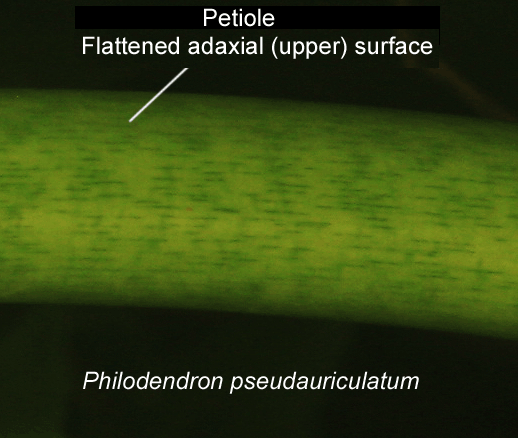 along with
nutrients through the petiole's cellular structure
along with
nutrients through the petiole's cellular structure
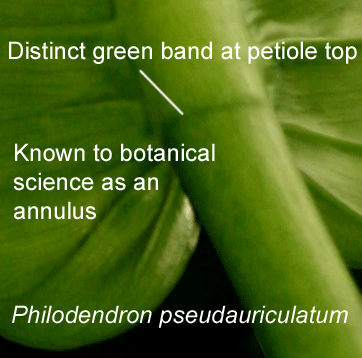 (xylem) to the leaf blades
using a specialized form of hydraulic pressure. The unique upwards pull on
the water is actually caused by the evaporation of water through the leaves.
(xylem) to the leaf blades
using a specialized form of hydraulic pressure. The unique upwards pull on
the water is actually caused by the evaporation of water through the leaves.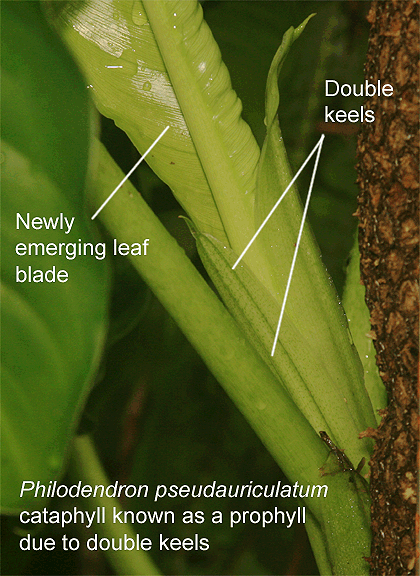 right). The
cataphyll is the singular most important identifying characteristic of an
aroid. The purpose of the cataphyll is to protect the new leaf as it
develops.
The
cataphylls of
Philodendron
pseudauriculatum are moderately spongy and grow to 18 to 27
cm (7 to 10.6 inches) long. The petioles of the species
are somewhat
distinctive since
they are sharply double ribbed (double keeled). A double keeled (2 ribbed)
cataphyll is known as a prophyll although there is no distinction in its
purpose. The cataphyll is medium green with dense
dark
green short lineation (lines). Once the blade emerges the
cataphyll
becomes deciduous and drops from the plant.
right). The
cataphyll is the singular most important identifying characteristic of an
aroid. The purpose of the cataphyll is to protect the new leaf as it
develops.
The
cataphylls of
Philodendron
pseudauriculatum are moderately spongy and grow to 18 to 27
cm (7 to 10.6 inches) long. The petioles of the species
are somewhat
distinctive since
they are sharply double ribbed (double keeled). A double keeled (2 ribbed)
cataphyll is known as a prophyll although there is no distinction in its
purpose. The cataphyll is medium green with dense
dark
green short lineation (lines). Once the blade emerges the
cataphyll
becomes deciduous and drops from the plant. 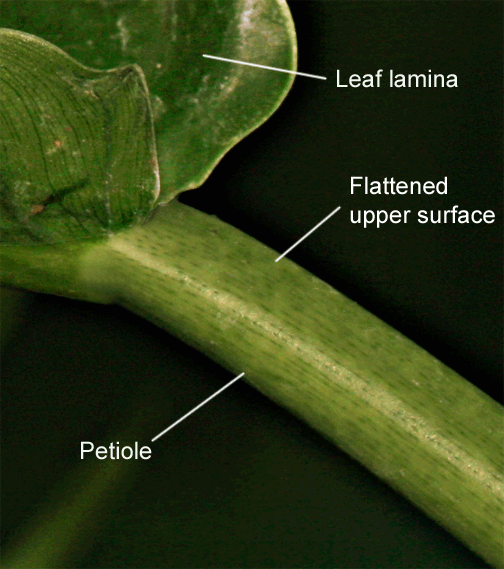 Along the stem can be observed
nodes which are divided by stem sections known as internodes. The internodes of
Philodendron pseudauriculatum
are short as well as gray green in color.
The are also glossy
to semi-glossy in sheen. The stems are often slightly flattened
on one side and may exhibit a short series of transverse ridges which
may be observed just below the nodes on both sides of the rounded portion of
internodes. The roots which grow from the nodes are dark brown as well as slender. Few roots grow from
any
single node.
Along the stem can be observed
nodes which are divided by stem sections known as internodes. The internodes of
Philodendron pseudauriculatum
are short as well as gray green in color.
The are also glossy
to semi-glossy in sheen. The stems are often slightly flattened
on one side and may exhibit a short series of transverse ridges which
may be observed just below the nodes on both sides of the rounded portion of
internodes. The roots which grow from the nodes are dark brown as well as slender. Few roots grow from
any
single node.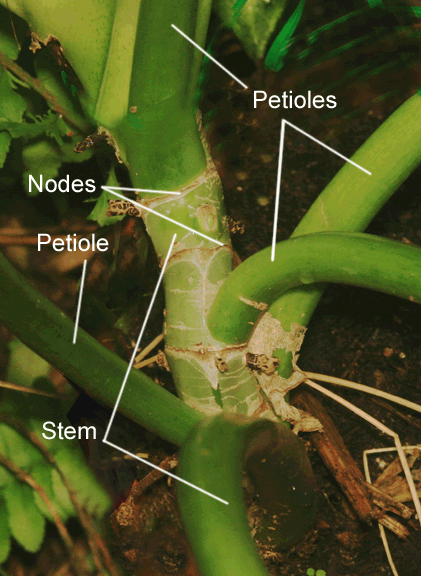 magnifying
glass on the true flowers along the spadix.
When an aroid is referred to as "flowering" the
reference is to the very small flowers which are produced
along the spadix
and has nothing to do with the spathe. The
only connection is
both are produced during the plants sexual reproduction known as anthesis.
magnifying
glass on the true flowers along the spadix.
When an aroid is referred to as "flowering" the
reference is to the very small flowers which are produced
along the spadix
and has nothing to do with the spathe. The
only connection is
both are produced during the plants sexual reproduction known as anthesis. 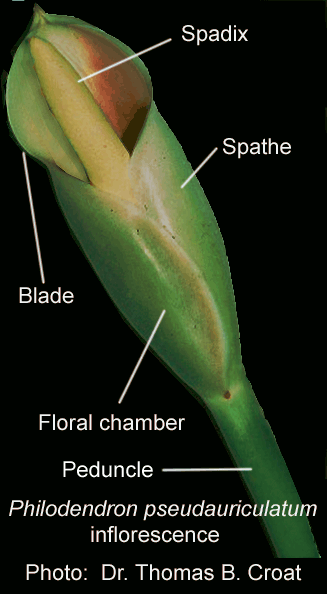 Once mature
Philodendron pseudauriculatum
produces two to three inflorescences per axil. The peduncles which
supports the inflorescences measure between 5.5 and 21 cm but may grow
up to 25 cm (2.1 to 9.85 inches) in length and are
the internodes between the spathe and the last foliage leaf.
The peduncle is medium to pale green and
is finely striated. The botanical term striate indicates fine
parallel lines. The spathes are green and somewhat pinkish and measure between 12 and 23 cm
(4.7 to 9 inches) in length
and are constricted midway up the spathe tube. The spathe
coloration has
white to pinkish
on the margins (edges). The spathe
blade (the upper margin of the tube) is creamy white to yellowish
green with a faint green tinge at the center on the backside while yellow orange striated on the outside and pale green to
whitish on the inside. The spathe tube is oblong to ellipsoid and
is sometimes sometimes slightly tinged purplish along the outside margins.
Flowering
in Philodendron pseudauriculatum occurs during the dry season in
Central America as well as the first half of the rainy season which is January through September.
Mature fruits are only known to be observed after September.
Once mature
Philodendron pseudauriculatum
produces two to three inflorescences per axil. The peduncles which
supports the inflorescences measure between 5.5 and 21 cm but may grow
up to 25 cm (2.1 to 9.85 inches) in length and are
the internodes between the spathe and the last foliage leaf.
The peduncle is medium to pale green and
is finely striated. The botanical term striate indicates fine
parallel lines. The spathes are green and somewhat pinkish and measure between 12 and 23 cm
(4.7 to 9 inches) in length
and are constricted midway up the spathe tube. The spathe
coloration has
white to pinkish
on the margins (edges). The spathe
blade (the upper margin of the tube) is creamy white to yellowish
green with a faint green tinge at the center on the backside while yellow orange striated on the outside and pale green to
whitish on the inside. The spathe tube is oblong to ellipsoid and
is sometimes sometimes slightly tinged purplish along the outside margins.
Flowering
in Philodendron pseudauriculatum occurs during the dry season in
Central America as well as the first half of the rainy season which is January through September.
Mature fruits are only known to be observed after September.
Join the International Aroid Society: http://www.exoticrainforest.com/Join%20IAS.html
If you are seeking information on other rare
species, click on "Aroids and other genera in the Collection" at the top and look for the